Indonesian Retrospective
Yogyakarta
Yogya was my first real taste of Indonesia, I had passed through Jakarta on the way but I barely even left the airport. After my flight was delayed at Jakarta I arrived at Yogya at about 7pm. All I really felt like doing at this stage was going straight to the Hotel and going to sleep - I met up with my friends at the airport and we jumped into a taxi and headed off to the hotel.
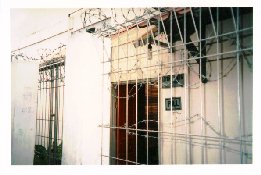 The taxi dropped us off and I looked around trying to spot the Hotel. I ended up following my friends down a narrow alley until we reached a small building with a high steel fence topped with barbed wire - we pulled the wire aside and entered. This was my introduction to a Losman, one of many that we would stay in during our travels.
The taxi dropped us off and I looked around trying to spot the Hotel. I ended up following my friends down a narrow alley until we reached a small building with a high steel fence topped with barbed wire - we pulled the wire aside and entered. This was my introduction to a Losman, one of many that we would stay in during our travels.
Yogyakarta was one of the nicest cities that I stayed in while in Indonesia. The Javanese people were very friendly - I never heard any of the locals so much as raise their voice in anger - it was a pleasant change from the high-stress environment of university and exams. After spending the first day wondering around the city getting into the Indonesian speed of life I got the camera out and headed for the tourist sites.
Kraton
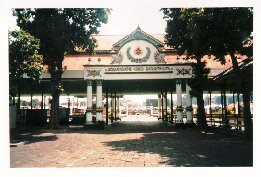
|
In the center of Yogyakarta, the palace of the sultans of Yogya form a small, walled, city within a city. Although the sultan still lives in the innermost group of buildings, the Kraton now forms something of a giant museum and is only open from 8am to 1pm to the public.
|
|
Close to Kraton we also saw examples of the Batik artwork for which Yogya is renowned - and how it is made.
|
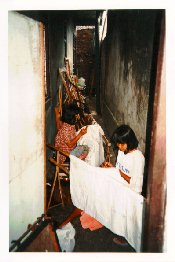
|
Wayang
Java is one of the traditional centers of the wayang, which are performances telling Hindu stories in the style of puppets or dancing. There are three distinct types of wayang:
- Wayang Kulit - Where leather puppets are held up against a back-lit screen to create a shadow.
- Wayang Orang - Where people dance in acting out the play.
- Wayang Golek - Where three dimensional wooden puppets are used for the actors.
While in Yogyakarta I managed to see both a Wayang Kulit and a Wayang Orang which were very different but interesting in their own rights.
Wayang Kulit

The Wayang Kulit is a shadow-puppet display which is traditionally performed by a single puppeteer, or dalang, who also provides the voices for each of the players. The language used is the old Javanese which very few people still speak, and the performances traditionally go all night. The dalang is a highly respected (and highly paid) artist in Indonesian culture, and understandably so - training for the qualifications can take many years.
The performance is accompanied by the gamalan orchestra which seems to have an amazing talent for knowing when to play what, and have time for a smoke between each act.
Wayang Orang
The Wayang Orang performance we saw was performed in an excellent setting in an open-air amphitheatre with a dramatically lit temple as a backdrop to the performance and a full moon in the sky.
The scenes all seemed to have a similar theme - a big battle and then the hero's enter the scene and calmly shoot the bad guys with their bow and arrows. This was somewhat frustrating for me, I couldn't figure out why no-one else had bows and arrows - it all seemed a just a bit unfair for the bad guys..
This play, as with the Wayang Kulit, was based on the Hindu epics; the Ramayana and the Mahabharata, just as all Wayang are based, along with some Javanese stories.
Borobodur
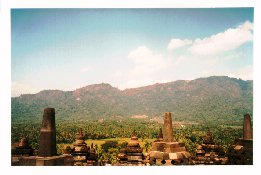
Borobodur was built by the rulers of the Sailendra dynasty sometime between 750 and 850 AD. Little is known about the early history of the temple though, with the decline of Buddhism in Java, Borobodur was abandoned soon after completion.
It wasn't until 1815 that the site was cleared of accumulated mud and ash. Complete restoration of the site was not undertaken until 1973 when the Indonesian government began a project which would take $US21 million and eleven years to complete.
The Borobodur temple is immense - built around the top of a hill with six square terraces forming the base and topped by three circular levels. Along with walls of each terrace are carved the Buddhist doctrines and stories of Javanese life, walking (clockwise of course) around the terraces on each level is a 5km walk.
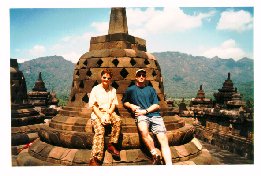 Borobodur is now a top tourist spot for Indonesia. Not only were there the western tourists, but a surprising number of Indonesians making the climb to the top. Indonesia is probably one of the only places where the tourists can be tourist'ed back by the locals - wanting to take your photo and have their photo taken with you to show their friends. Some people say that the only reason Indonesians holiday in Bali is to watch all the funny Westerners.
Borobodur is now a top tourist spot for Indonesia. Not only were there the western tourists, but a surprising number of Indonesians making the climb to the top. Indonesia is probably one of the only places where the tourists can be tourist'ed back by the locals - wanting to take your photo and have their photo taken with you to show their friends. Some people say that the only reason Indonesians holiday in Bali is to watch all the funny Westerners.
The temple was very impressive with excellent views from the top and, if you reach inside the domes at the top, you can touch Budda and give yourself good luck or something... very cool.
Mount Merapi
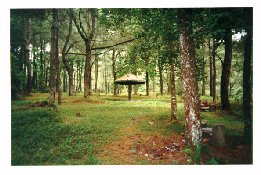
After piling into the various forms of Indonesian public transport to reach Mt Merapi - at one stage I counted over 25 people in a minibus the size of a VW combi - we reached the base of the mountain. We didnt actually climb to the top of Mount Merapi, though we did go for a nice walk around the base which led to a stream and exposed just how unfit we all were. In retrospect I am glad we did not try to climb the mountain - it is reputed to be one of the most difficult climbs in Java and is often closed because of dangerous sulphur fumes due to the volcanic nature of the region.

After leaving the walk we got a bit lost heading back into the town at the base of Merapi. After wondering around for a bit and taking the advice of a friendly Indonesian couple we eventually make our way into a Satay restaurant for some much-needed food before heading back into Yogyakarta.
[ Index | 1 | 2 | 3 | 4 | 5 | 6 | Photos ]

 The taxi dropped us off and I looked around trying to spot the Hotel. I ended up following my friends down a narrow alley until we reached a small building with a high steel fence topped with barbed wire - we pulled the wire aside and entered. This was my introduction to a Losman, one of many that we would stay in during our travels.
The taxi dropped us off and I looked around trying to spot the Hotel. I ended up following my friends down a narrow alley until we reached a small building with a high steel fence topped with barbed wire - we pulled the wire aside and entered. This was my introduction to a Losman, one of many that we would stay in during our travels.






